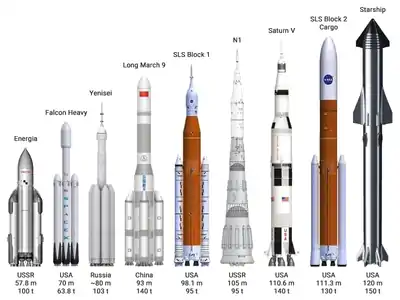Yenisei (rocket)
Yenisei (Russian: Енисей), project name RN STK-1 (Raketa-Nositel' SverkhTyazhologo Klassa - Launch vehicle super-heavy class), is the first super-heavy launch vehicle being developed by the Russian space industry since the fall of the USSR. The main developer is RSC Energia.
| Function | Orbital Launch Vehicle |
|---|---|
| Manufacturer | RSC Energia |
| Country of origin | Russia |
| Project cost | 1.5 trln Roubles |
| Cost per launch | 4 times lower than SLS (according to Rogozin) |
| Size | |
| Diameter | Core stage: 4.1 m |
| Mass | 3167 tons |
| Capacity | |
| Payload to LEO | 103-140 tons |
| Associated rockets | |
| Comparable | Falcon Heavy, Long March 9, Space Launch System |
| Launch history | |
| Status | In development |
It is being developed within the framework of the federal target program "Creation of a super-heavy class space rocket complex for 2020-2030"[1] and the program cost is estimated at 1.5 trillion roubles. It is the main rocket of the Russian Lunar program.
The final design for the rocket is expected to be complete by autumn 2021.[2]
The first launch is expected to happen in 2028 from the Vostochny cosmodrome.[3]
Based on the Yenisei launch vehicle, the Don launch vehicle (RN STK-2) is being developed by adding another stage.[4]
Development
The rocket got its name at the end of 2018, before that it was called "RN STK" (super-heavy launch vehicle).
Chronology of development.
| Event | Date |
|---|---|
| Start of work on the creation of the RD-171MV engine | June 2017 |
| Start of research work on RD-0150 engine | June 2017 |
| Preliminary estimate of the cost of R&D on the RN STK | October 2017 |
| Decree of the President of the Russian Federation on the creation of the RN STK | January 2018 |
| Official name for RN STK | January 2019 |
| Feasibility study of the RN STK project | Spring 2019 |
| Draft design | 2018-2019 |
| R&D, design, and construction works | 2020-2028 |
| Flight tests | from 2028 |
Planned events
- October 2021 - end of technical design.[2]
- 2026-2028 - construction and commissioning of infrastructure for a super-heavy launch vehicle and a medium-class rocket for launching crewed spacecraft from the Vostochny cosmodrome.[5]
Design
The first stage will consist of 6 blocks, each block will be based on the first stage of the planned Irtysh / Soyuz-5 rocket with an RD-171MV engine.[6]
The second stage will consist of one block - matching the first stage of Soyuz-6 - with RD-180 as engine.[6]
The upper stage will be KVTK[6]
Accelerating braking unit: Block DM[6]
Proposed variants
| Name of a rocket | Yenisei[7][6][8][9] | Don[7][9] |
|---|---|---|
| Type | Stage one | Stage two |
| First launch | 2028 | 2032-2035 |
| First stage | 6xRD-171MV | 6xRD-171MV |
| Second stage | RD-180 | RD-180 |
| Third stage | - | 2×RD-0150 |
| Upper stage | KVTK, 2×RD-0146 | KVTK, 2×RD-0146 |
| Accelerating braking unit | DM, 11D58MF | DM, 11D58MF |
| Height (max.) | ||
| Launch weight, t | 3167 | 3281 |
| Thrust (at ground level) | ||
| Thrust-to-weight ratio | ||
| Payload (LEO 200 km), t | 103 | 140 |
| Payload (GTO 5500 km), t | ||
| Payload (GEO 35,786 km), t | 26 | 29.5 |
| Payload to TLI | 27 | 33 |
Flight tests

Flight tests of a super-heavy launch vehicle will take place in two stages from 2028 to 2035.[10]
The first stage of testing will take place in 2028-2032. It involves the launch of a crewed spacecraft, a lunar take-off and landing complex (LVPK) and other payloads on the trajectory of the flight around the Moon and circumlunar orbits in order to work out the elements of a crewed complex, create a station in the orbit of the Moon, and land on the lunar surface.
The second stage of testing will take place in 2032-2035. It is planned to launch LVPK and other uncrewed payloads for the construction and operation of a base on the lunar surface. In addition, this stage involves participation in international programs related to the study of Mars.
Applications
The super-heavy rocket is supposed to be used in the Russian lunar program, since the carrying capacity of the Angara-A5V launch vehicle (37.5 tons to LEO) is insufficient for these purposes.
Lunar program payloads
- 20-ton Orel spacecraft.
- 27-ton lunar landing and takeoff complex (LPVK).
- 32-ton lunar base module.
Satellite constellation
- Spacecraft up to 30 tons to geostationary orbit
- Space telescopes 30-40 tons to the L2 Lagrange point in the Sun-Earth system
References
- "Russia has developed the concept of the Federal Target Program for the creation of a super-heavy rocket (in Russian)". Ria Novosti. 28 May 2019.
- "The design of the Russian super-heavy rocket will be completed in 2021 (In Russian)". Izvestia. 23 August 2020.
- "Roskosmos has named the timing of the launch of a super-heavy rocket (in Russian)". Ria Novosti. 17 July 2018.
- "Possible dates for the launch of the Don super-heavy rocket have been named (in Russian)". Ria Novosti. 14 February 2019.
- "Russian super-heavy rocket will be able to launch at least 70 tons of cargo into orbit (In Russian)". TASS. 14 July 2017.
- "New generation locomotives (in Russian)". Russkiy Kosmos. 15: 34–39. 2020.
- "Roscosmos unveils characteristics of super-heavy rockets for flights to the Moon (In Russian)". Ria Novosti. 24 April 2019.
- "The Yenisei super-heavy rocket". RussianSpaceWeb.
- "Transformation of Roscosmos". Russki Kosmos. 7: 2–7. July 2019.
- "RSC Energia: flight tests of the Soyuz-5 rocket will take place from 2022 to 2025 (In Russian)". TASS. 3 July 2018.
